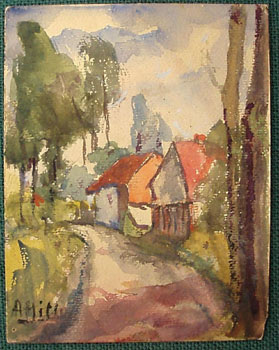
He may have been one hell (literally) of a dicator, but he was one extremely average painter.
These images show the handiwork of a young Adolf Hitler, when he still entertained the fantasy that he was, and would one day be recognised, as a great artist.

The history of these paintings appears to be sketchy, and they are being promoted as "believed to have been painted by Hitler". Presumably it's hard to authenticate the 'art' of one of history's greatest monsters.
Hitler is estimated to have completed some 3000 paintings before he turned to politics, and collecting his art has long been a controversial and extremely competitive business in the United States.
From the Daily Mail (UK) :
Few would give house room to the indifferent scenes of churches, cottages and woodland. Even the auctioneer concedes the amateurish paintings have little artistic merit and would perhaps raise £1 apiece if they went under the hammer.
But a closer look at the signature penned in the corner of the 21 watercolours and two rough drawings might explain why bidders from around the world descended on a quiet Cornish hotel yesterday.
....the pictures are signed AH or A Hitler and believed to be the work of the Nazi dictator, drawn while a young corporal billeted on the France/Belgium border in the First World War.
As a boy Adolf Hitler fantasised at becoming a painter but was twice turned down by Vienna's Academy of Fine Art for lack of talent.
Whatever the childhood artistic abilities, his notoriety pushed prices way above the estimates at the Hitler sale.
For 70 years the paintings sold yesterday had been tucked away in a suitcase gathering dust in a Belgian attic.They are believed to have been painted between 1915 and 1918 on the borders of France and Belgium where Hitler was a corporal.
Much of the work spent authenticating the paintings was carried out in Belgium. The paper was found to be the right age and the style matches other Hitler works but because 100% authentication could not be guaranteed the auctioneers sold them as 'attributed to Hitler.'
Said one of the auctioneers : "I fully admit the paintings are amateurish and their value was purely down to the artist. If it wasn't for who painted them they would probably not be worthy of selling."
The 23 watercolours and sketches raised a total of more than $US160,000, with the most expensive painting going for around $US14,000.
The modified gas bread ovens used to exterminate millions of Russians, Poles and Germans during the 1940s could also be called "pieces of history", but you wouldn't expect them to go up for auction.
Some people will blow their money on any old piece of crap, as long as they determine it has "name value".
Soon to be auctioned, Stalin's pisspot and Mussolini's muddy old boots. Maybe.
UPDATE : Good Christ, I just found a serious appreciation of Hitler's watercolours and an examination of his "artistic style" :
Comfortable with classical European styles, Hitler apparently was unable and unwilling to accept modern developments in art after 1910. Because the new schools broke radically with comfortable tradition and increasingly with reality itself, he branded them as "degenerate."
....he disliked modern works.
Hitler's fascination with and preference for the realism of the 19th century remained unshakable. His typical landscapes, city scenes and still lifes all dearly indicate how completely he was captivated by conventional forms of expression.
Even though Vlenna was at the height of the art nouveau era during Hitler's years in the city (1907?1913), he was totally unaffected by the movement, and continued to paint conservative subjects in older styles.
Of course, one should not ignore the fact that such traditional themes and styles were the preferred taste of his customers from Vienna's lower middle class. As can be seen in numerous paintings in the catalogue, he frequently copied well-known city views, old engravings and popular paintings of an earlier era: they were undoubtedly easier to sell.
Hitler believed that the foremost requirement for an artist was the ability to reproduce details of life in realistic form. This attention to detail can be seen in his landscapes, city scenes and architectural designs.
Hitler believed that a "proper sensitivity for art," as he expressed it, governed the content of art as well as the techniques. Above all, the subject matter must be understandable for the masses.
"Healthy" art has a "healthy soul," he claimed. It should be "uplifting," "noble," and "idealistic."
He considered certain themes such as the family, everyday work, mythology, rural life and landscapes, the perfected human body, or the heroic soldier to be subjects worthy of art.
His insistence on what he considered "normal" and "healthy" attributes obviously conflicted with the emerging schools of modern art - Impressionism, Expressionism, Cubism, Dadaism, etc.
He claimed these "terrible aberrations" were produced by "scribblers, canvas scrawlers, mental defectives or cultural Neanderthals."
Cultural Neanderthals? Mental defectives?
Wow.
Hitler didn't just do boring landscapes. He also painted and sketched buildings, nudes and...dogs.

Hanging A Hitler In Your Hallway - The Art Of Evil
No comments:
Post a Comment